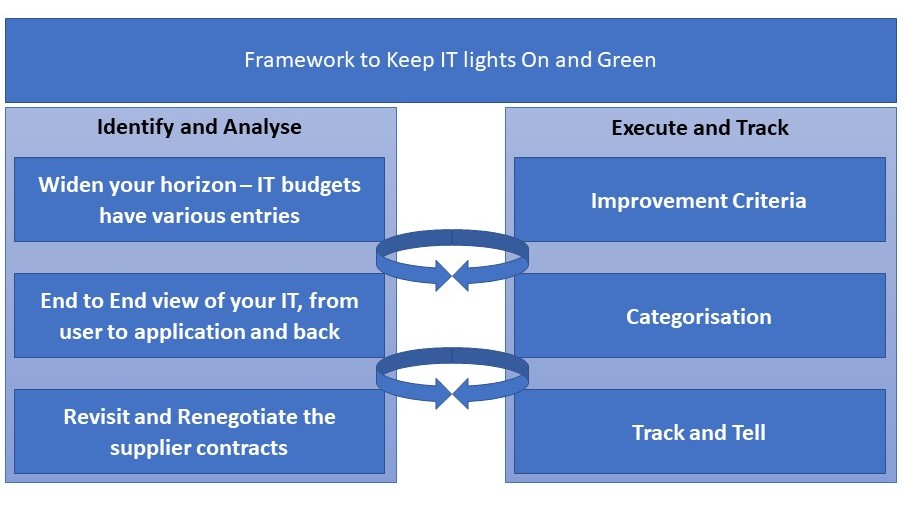As the economy takes a nosedive, the IT teams are going through a double whammy. While the pandemic increased the burnout at work for at least 30% of the workforce, IT spends reduced by a minimum of 5%-8% in the majority of the countries.
The transformation projects have either been delayed, canceled, or their budgets highly reduced and the aim for most of the companies is to “keep the lights on”. However, these lights have to be longer and consistently on, and they need to be Green too. By that I mean the IT needs to be continuously available (On) and highly performant (Green).
While there is no magic wand to achieve this, below are some of the considerations and pointers that can be useful.
Identify and Analyse
- Widen your horizon – IT budgets have various entries: The IT run budget is usually around 70% of the overall IT budget. So, while you may have seen them reducing, there are still plenty of components that contribute to this. Identify every item by making a list of everything that is, directly and indirectly, related to IT including the obvious ones like hardware, software, personnel, and non-obvious ones like Business Unit IT and Shadow IT.
- End to End view of your IT, from user to application and back: Do an end to end analysis of your IT, at least for critical and important applications. This includes the journey from the first keystroke form end-user device to server room/data centre/cloud via the network links and hops (office network, home broadband, internet), underlying infrastructure (server, storage, operating system) to applications and databases (structure, layers, integration) and back to the end-user device. Invest in a tool to have data that you can trust and engage with end-user and businesses to set the right expectations and ways of working. The limitations identified can be then fixed, gaps between the perception and reality abridged.
- Revisit and Renegotiate the supplier contracts: Irrespective of the size of your organisation, there’s always going to be multiple suppliers in your IT ecosystem. Evaluate the contracts to see if you are still using all the services you have signed for, explore combining offerings from other suppliers, renegotiate the service contracts and even explore the buyout of one supplier’s exit fees by other suppliers.
Execute and Track
Once you identified and analysed the areas of improvement and fix, have a fixed timeline to execute the changes. Track and trace each of the initiative and changes for maximum visibility, using the following parameters:
- Improvement Criteria: Mark each identified area of improvement against the following criteria:
- Business impact (none, low, medium, high)
- Customer impact (none, low, medium, high)
- Skills availability (yes, buy)
- Investment required (none, small, high)
- Cost realisation (none, immediate, long term)
- Categorisation: The areas of improvement can then be categorised into the following:
- Eliminate
- Rationalise
- Long term
- Track and Tell: Every initiative will give some percentage of improvement, optimisation, and productivity gain. Identify it and showcase it to internal IT staff to boost their morale, to business to gain and enhance their confidence and finally to the end customer about the direct and indirect benefits to them. Remember every percentage point should be considered as in the end it all adds up.
The above approach is applicable for organisations of all size and scale and given it combines a top-down and bottom-up approach may sound daunting, but it’s worth the effort. So, give it a try and good luck on your journey to keep the IT lights on and green. You can also avail a non-obligatory free advisory to get started. Book a slot at simplex-services.com.
Photo by Oskar Yildiz on Unsplash

